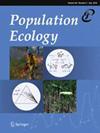Relative contributions of fixed and dynamic heterogeneity to variation in lifetime reproductive success in kestrels ( Falco tinnunculus )
IF 1
4区 环境科学与生态学
Q4 ECOLOGY
引用次数: 6
Abstract
Many species show large variation in lifetime reproductive success (LRS), with a few individuals producing the majority of offspring. This variation can be explained by factors related to individuals (fixed heterogeneity) and stochastic differences in survival and reproduction (dynamic heterogeneity). In this study, we study the relative effects of these processes on the LRS of a Dutch Kestrel population, using three different methods. First, we extended neutral simulations by simulating LRS distributions of populations consisting of groups with increasingly different population parameters. Decomposition of total LRS variance into contributions from fixed and dynamic heterogeneity revealed that the proportion of fixed heterogeneity is probably lower than 10% of the total variance. Secondly, we used sensitivities of the mean and variance in LRS to each parameter to analytically show that it is impossible to get equal contributions of fixed and dynamic heterogeneity when only one parameter differs between groups. Finally, we computed the LRS probability distribution to show that even when all individuals have identical survival and reproduction rates, the variance in LRS is large (females: 27.52, males: 12.99). Although each method has its limitations, they all lead to the conclusion that the majority of the variation in kestrel LRS is caused by dynamic heterogeneity. This large effect of红隼(Falco tinunculus)终生生殖成功变异的固定和动态异质性的相对贡献
许多物种在终生繁殖成功率(LRS)方面表现出很大的差异,少数个体产生大多数后代。这种差异可以用个体相关因素(固定异质性)和生存和繁殖的随机差异(动态异质性)来解释。在本研究中,我们使用三种不同的方法研究了这些过程对荷兰红隼种群LRS的相对影响。首先,我们通过模拟由种群参数越来越不同的群体组成的种群的LRS分布来扩展中性模拟。将LRS总方差分解为固定异质性和动态异质性的贡献,发现固定异质性的比例可能低于总方差的10%。其次,我们利用LRS中均值和方差对每个参数的敏感性分析表明,当组间只有一个参数不同时,不可能得到固定和动态异质性的相等贡献。最后,我们计算了LRS概率分布,结果表明,即使所有个体的存活率和繁殖率相同,LRS的方差也很大(雌性:27.52,雄性:12.99)。尽管每种方法都有其局限性,但它们都得出了红隼LRS的大部分变异是由动态异质性引起的结论。这种巨大的影响
本文章由计算机程序翻译,如有差异,请以英文原文为准。
求助全文
约1分钟内获得全文
求助全文
来源期刊

Population Ecology
环境科学-生态学
CiteScore
3.90
自引率
11.80%
发文量
41
审稿时长
18-36 weeks
期刊介绍:
Population Ecology, formerly known as Researches on Population Ecology launched in Dec 1952, is the official journal of the Society of Population Ecology. Population Ecology publishes original research articles and reviews (including invited reviews) on various aspects of population ecology, from the individual to the community level. Among the specific fields included are population dynamics and distribution, evolutionary ecology, ecological genetics, theoretical models, conservation biology, agroecosystem studies, and bioresource management. Manuscripts should contain new results of empirical and/or theoretical investigations concerning facts, patterns, processes, mechanisms or concepts of population ecology; those purely descriptive in nature are not suitable for this journal. All manuscripts are reviewed anonymously by two or more referees, and the final editorial decision is made by the Chief Editor or an Associate Editor based on the referees'' evaluations.
 求助内容:
求助内容: 应助结果提醒方式:
应助结果提醒方式:


